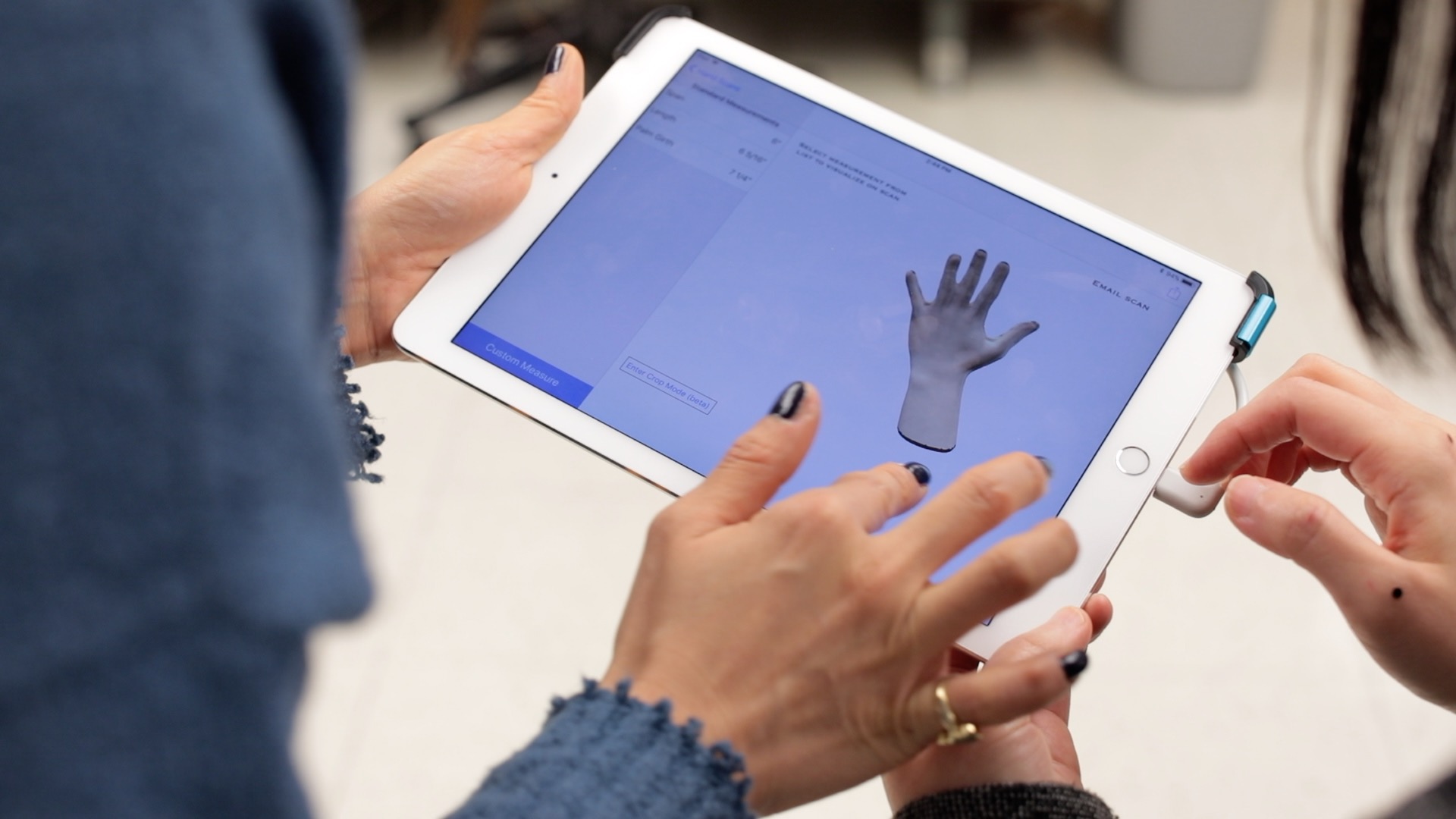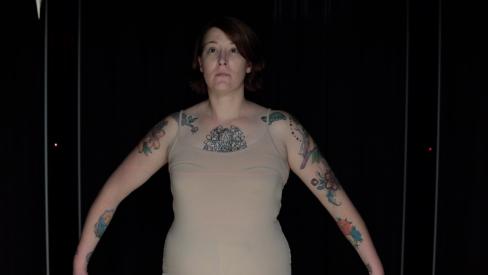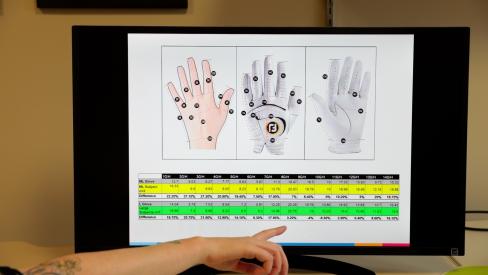Method Development

As dynamic anthropometric data becomes more readily available, the future of anthropometry has the ability to influence innovation at the critical intersection of ergonomics and the sizing and fit of advanced wearable products.
Overview
Dynamic Anthropometry
The Human Dimensioning Lab develops new methods to use dynamic anthropometry to encourage more robust, data-driven design development for products in need of lifesaving innovation. Our research transforms the frontiers of human factors and wearable products by enabling the measurement of complex dynamic surfaces. Through merging body-product knowledge with material science innovation, future dynamic data will be a catalyst for innovation in wearable product development. The human dimensioning lab will continue to extend their research ability to quantify dynamic fit of wearable products, advance product knowledge in performance biomechanics by capturing the quantity and mechanics of two surfaces exerting force during movement, inform safety protocols for PPE and other wearable products, and enhance collaboration between a range of disciplines. The future in this space will help define and shape new paradigms of research and will improve the capacity to develop wearable products for medical, space, and beyond.

3D Hand Scanning

Over the last 4 years, in collaboration with researchers at the University of Oregon, the HDL has demonstrated a true need for detailed analysis of static and dynamic hand measurements. In 2019, the HDL team created a first of its kind large-scale 3D hand anthropometric database with over 800 hand scans. The database includes multiple types of data; 1) population information, 2) participant hand history and glove fit issues, 3) manual measurements, and 4) two scanned hand positions with landmarks.
Exploring the application of new 3D hand data has been a top priority of the lab. New technologies such as 3D simulation and digital prototyping offer endless design opportunities for gloves and hand tools. One potential application is digitally draping, which can be used to improve glove fit.The HDL anthropometric data and design research will inform functional glove and tool design for a range of fields and consumers.
Featured Projects
Dynamic Anthropometric Assessment of the Waist-Hip-Thigh
Kimberly Clark Corporation
The purpose of this study was to develop an integrated landmarking method to analyze waist-hip-thigh scans captured with an Artec Leo handheld scanner. Analyzing dynamic shape change of the body and product performance requires the integration of the scanning technology and new landmarking methods. This integration quantifies the shape of the body by using 1D, 2D, and 3D measurements to capture the 3D complexity of the body. Understanding percentage changes of the body in different positions can suggest data-based design decisions for products to act as a second skin.
Publications
Griffin, L., Juhnke, B., Seifert, E. & Pokorny, C. (2019, October). Method to Capture and Analyze the Waist-Hip-Thigh Body Region of Seated-Standing 3D Scans.10th 3DBODY.TECH Conference and Expo, Lugano, Switzerland. https://doi.org/10.15221/19.254
Griffin, L., Juhnke, B. & Seifert, E. (2019, October). Landmarking Method to Capture Dynamic Anthropometric Measurements of the Waist-Hip-Thigh Body Region. International Textile and Apparel Association Annual Conference Proceedings, Las Vegas, Nevada, USA.
Griffin, L., Juhnke, B., & Seifert, E. (2019, October). Dynamic Anthropometric Analysis of the Waist-Hip-Thigh Body Region. International Textile and Apparel Association Annual Conference Proceedings, Las Vegas, NV, USA.
Griffin, L., Juhnke, B., (2019) Application of Dynamic Anthropometry for Product Design. Presented at the 2019 Applied Human Factors and Ergonomics Conference, Washington, D.C., USA. July, 2019.
4D Dynamic Surface Capture Research: Exploring New Frontiers in Advanced Wearable Product Development
Grant-In-Aid, University of Minnesota
The purpose of this study was to collect and analyze data from the 3dMD 4D System, and create a model for how to use 4D data in future wearable product design research. The 4D full-body system captures and generates a series of 360-degree true anatomical body models over a period of time. 4D scanners have the ability to collect traditionally “hard-to capture” parts of the body like hands, while incorporating dynamic motion.
Publications
Pei, J. & Griffin, L. (2019). The Study of Breast Shape During Running Using 4D Scanning Technology, (under review).
Pei, J., Griffin, L., Fan, J., & Ashdown, S. (2019). The Detection of the Upper Boundary of Breasts Using 4D Scanning Technology. 3DBODY.TECH Conference and Expo, Lugano, Switzerland. doi:10.15221/19.266
Griffin, L. & Juhnke, B. (2019). Application of Dynamic Anthropometry for Product Design. Applied Human Factors and Ergonomics Conference, Washington, D.C., USA.
Griffin, L., Juhnke, B., Seifert, E., Curry, C., Duran, K., & Pei, J. (2019). A Model for 4D Scanning Research in Apparel. International Textile and Apparel Association Annual Conferences Proceedings, Las Vegas, NV, USA.
3D Anthropometric Hand Assessment and Glove Design for Occupational Workers
Agriculture Experiment Station
The purpose of this research is to conduct a dynamic, 3D anthropometric survey of hands to build a database of scans that can then be measured and analyzed using a consistent methodology. This will include detailed ergonomic and anthropometric analysis of the hand in dynamic positions. To date, we have created a database of over 600 participant hands.
Publications
Sokolowski, S., Griffin, L., Juhnke, B., & Pokorny, C. (2020, July). Qualitative Survey Methodology and Data Collection for Performance Glove Design and Fit. Accepted in International Conference on Applied Human Factors and Ergonomics.
Juhnke, B., Pokorny, C., Griffin, L., & Sokolowski, S. (2020, July). Lend a Hand for 3D Scans: Scanning Methodology and Data Collection for Tool and Glove Design. International Conference on Applied Human Factors and Ergonomics.
Pokorny, C., Juhnke, B., & Griffin, L. (2020, July). A Visible Functional Grasp to Measure the Complete Hand. International Conference on Applied Human Factors and Ergonomics.
Griffin, L., Sokolowski, S., Savvateev, E., Bhuyan, A., & Roese, N. (2019, October). Comparison of Glove Specifications, 3D Hand Scans, and Sizing of Sports Gloves for Female Athletes. In Proc. of 3DBODY.TECH 2019 - 10th Int. Conf. and Exh. on 3D Body Scanning and Processing Technologies, Lugano, Switzerland. doi: 10.15221/19.109
Seifert, E., Curry, C., & Griffin, L. (2019, October). Feasibility of Digital Draping for Improved Glove Fit. In Proceedings of the 2019 conference of the International Textile and Apparel Association, Las Vegas, NV, USA.
Seifert, E., Pokorny, C., Griffin, L., & Holschuh, B. (2019, October). Validation of the Artec Eva for Hand Anthropometric Data Collection. Presented at the In Proceedings of the 2019 conference of the International Textile and Apparel Association, Las Vegas, NV, USA.
Curry, C., Griffin, L., Seifert, E., & Sokolowski, S. (2019). 3D Hand Scanning to Digital Draping for Glove Design. International Conference on Applied Human Factors and Ergonomics, Washington, D.C., USA. https://doi.org/10.1007/978-3-030-20470-9_14.
Sokolowski, S. & Griffin, L. (2019). Women’s Leather Protective Workwear Gloves: A Comparative Pilot Study Between 3D Hand Scans, Product Specifications, and Sizing. 11th Symposium on Performance of Protective Clothing and Equipment: Innovative Solutions to Evolving Challenges, Denver, CO, USA.
Griffin, L., Seifert, E., Curry, C., & Sokolowski, S. (2019). 3D Hand Scanning to Digital Draping for Glove Design. In International Conference on Applied Human Factors and Ergonomics, pp. 112-123. Springer, Cham. https://doi.org/10.1007/978-3-030-20470-9_14.
Seifert, E., Curry, C., & Griffin, L. (2019, July). 3D Anthropometric Assessment of Functional Hand Grasps for Surgeons and Medical Professionals. In 2019 Design of Medical Devices Conference. American Society of Mechanical Engineers Digital Collection.
Curry, C., Seifert, E., & Griffin, L. (2019, March). Using Natural Hand Positions to Improve Product Design Data in Health Care. Presented International Symposium on Human Factors and Ergonomics in Health Care, Chicago, IL, USA.
Griffin, L., Sokolowski, S., & Seifert, E. (2018). Process Considerations in 3D Hand Anthropometric Data Collection. In Proc. of 3DBODY.TECH 2018 - 9th Int. Conf. and Exh. on 3D Body Scanning and Processing Technologies, Lugano, Switzerland, pp. 121-130. https://doi.org/10.15221/18.121.
Sokolowski, S., Griffin, L., & Chandrasekhar, S. (2018). Current Technology Landscape for Collecting Hand Anthropometric Data. In Proc. of 3DBODY.TECH 2018 - 9th Int. Conf. and Exh. on 3D Body Scanning and Processing Technologies, Lugano, Switzerland, pp. 142-153. https://doi.org/10.15221/18.142.
Carufel, R., Lee, H., Nokyeon, K. Seifert, S., Griffin, L., & Sokolowski, S. (2018, October). Dimensions of the Dynamic Hand, an In-Depth Analysis of Dorsal vs. Palmar Lengths & Palmar Breadth. In Proceedings of the 2018 Conference of the International Textile and Apparel Association, Cleveland, OH, USA.
Griffin, L., Kim, N., Carufel, R., Sokolowski, S., Lee, H., & Seifert, E. (2018). Dimensions of the Dynamic Hand: Implications for Glove Design, Fit, and Sizing. In International Conference on Applied Human Factors and Ergonomics, pp. 38-48. Springer, Cham. https://doi.org/10.1007/978-3-319-94601-6_6.
Sokolowski, S., Griffin, L., Carufel, R., & Kim, N. (2018). Drawing Hands for Glove Design: Does the Data Match-Up?. In International Conference on Applied Human Factors and Ergonomics (pp. 68-77). Springer, Cham. https://doi.org/10.1007/978-3-319-94601-6_9.
Griffin, L., Sokolowski, S., Lee, H., Seifert, E., Kim, N., & Carufel, R. (2018). Methods and Tools for 3D Measurement of Hands and Feet. In International Conference on Applied Human Factors and Ergonomics (pp. 49-58). Springer, Cham. https://doi.org/10.1007/978-3-319-94601-6_7.
Kim, N., Carufel, R., & Griffin, L. (2018, March). A Three-Dimensional Assessment of Hand Dynamics: A Pilot Study of Seven Hand Positions. Presented at the 21st Annual Applied Ergonomics Conference, Atlanta, GA, USA.





